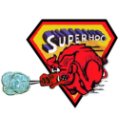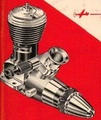Log in
Search
Latest topics
» Tee Dee .020 combat modelby rsv1cox Today at 9:00 am
» Roger Harris revisited
by rsv1cox Today at 7:35 am
» My latest doodle...
by batjac Yesterday at 10:05 pm
» Retail price mark-up.. how much is enough?
by gkamysz Yesterday at 9:29 pm
» Happy 77th birthday Andrew!
by roddie Yesterday at 9:22 pm
» My N-1R build log
by GallopingGhostler Yesterday at 3:04 pm
» Chocolate chip cookie dough.........
by roddie Yesterday at 1:13 pm
» Purchased the last of any bult engines from Ken Enya
by sosam117 Yesterday at 11:32 am
» Free Flight Radio Assist
by rdw777 Yesterday at 9:24 am
» Funny what you find when you go looking
by rsv1cox Wed Nov 20, 2024 3:21 pm
» Landing-gear tips
by 1975 control line guy Wed Nov 20, 2024 8:17 am
» Cox NaBOO - Just in time for Halloween
by rsv1cox Tue Nov 19, 2024 6:35 pm
Cox Engine of The Month
Cleaning the Threads of Tank Mounting Screws
Page 1 of 1
 Cleaning the Threads of Tank Mounting Screws
Cleaning the Threads of Tank Mounting Screws
Thought this MIGHT be a little over the top, but considering how some of you seem to suffer from the same O.C.D. that I do, figured I'd post this. If it's shown up previously, please forgive.
With the constant (and justified) emphasis on fuel and internal cleanliness, this is something I've been doing for a long time to help insure bits of goop don't face off with my needlevales.
A pretty good length of the mounting threads on tanked engines are constantly bathed in fuel as the engine does it's thing. Especially with older engines or restorations, the open threads can become packed like teeth needing a good flossing. Soaking and brushing will work, but I like to chuck them in a variable speed drill, and run a die down to the head and back, then re-soak them in my fuel tray.
There ALWAYS seems to be a considerable amount of goop deposits left in the die's channels, and I like to think that this MIGHT help avoid one of those moments when an otherwise friendly engine turns in to moody candidate for the parts bin.
This may hit either the limit for "Super-simple-minded-stuff-that-everybody-knows", or "Man!-you're-over-the-top-goofy!", but that's life in the Skunk Works...


With the constant (and justified) emphasis on fuel and internal cleanliness, this is something I've been doing for a long time to help insure bits of goop don't face off with my needlevales.
A pretty good length of the mounting threads on tanked engines are constantly bathed in fuel as the engine does it's thing. Especially with older engines or restorations, the open threads can become packed like teeth needing a good flossing. Soaking and brushing will work, but I like to chuck them in a variable speed drill, and run a die down to the head and back, then re-soak them in my fuel tray.
There ALWAYS seems to be a considerable amount of goop deposits left in the die's channels, and I like to think that this MIGHT help avoid one of those moments when an otherwise friendly engine turns in to moody candidate for the parts bin.
This may hit either the limit for "Super-simple-minded-stuff-that-everybody-knows", or "Man!-you're-over-the-top-goofy!", but that's life in the Skunk Works...


Last edited by Kim on Mon May 28, 2012 7:53 pm; edited 1 time in total

Kim- Top Poster




Posts : 8625
Join date : 2011-09-06
Location : South East Missouri
 Re: Cleaning the Threads of Tank Mounting Screws
Re: Cleaning the Threads of Tank Mounting Screws
I always make sure that the threads are clean on the ends where it enters the crankcase. I let the screws soak for a little bit then hit them with some paper towels and maybe some toothpicks if the crap won't come out of the threads.
 Re: Cleaning the Threads of Tank Mounting Screws
Re: Cleaning the Threads of Tank Mounting Screws
Kim,
Be careful not to cut the threads too many times or else they will not hold as well. A thread file may be a gentler solution to the same problem. By the way, this is a great idea that I have never considered.
Thanks,
Bob
Be careful not to cut the threads too many times or else they will not hold as well. A thread file may be a gentler solution to the same problem. By the way, this is a great idea that I have never considered.
Thanks,
Bob

fit90- Diamond Member

- Posts : 1341
Join date : 2011-08-11
Location : Naples, Florida
 Re: Cleaning the Threads of Tank Mounting Screws
Re: Cleaning the Threads of Tank Mounting Screws
.
Last edited by Mudhen on Fri Nov 12, 2021 8:56 am; edited 1 time in total

Mudhen- Gold Member

- Posts : 489
Join date : 2011-09-19
 Re: Cleaning the Threads of Tank Mounting Screws
Re: Cleaning the Threads of Tank Mounting Screws
fit90 wrote:Kim,
Be careful not to cut the threads too many times or else they will not hold as well. A thread file may be a gentler solution to the same problem. By the way, this is a great idea that I have never considered.
Thanks,
Bob
Yeah...I don't do it as a matter of regular maintenance, just long-sitters or strays that need some TLC....figured I'd mention it...with some of these, there's a BUNCH of goo that packs the die's channels. I like knowing that stuff is out of there!

Kim- Top Poster




Posts : 8625
Join date : 2011-09-06
Location : South East Missouri
 Re: Cleaning the Threads of Tank Mounting Screws
Re: Cleaning the Threads of Tank Mounting Screws
I hold my tank screws with pliers and assault them with the wire brush on the smaller of my two bench grinders. It does the job pretty well. It makes working on big engines, cars and lawn mowers, a whole lot easier. I would like to get a tap and die set for all of the Cox sizes.
_________________
Don't Panic!
...and never Ever think about how good you are at something...
while you're doing it!
My Hot Rock & Blues Playlist
...and never Ever think about how good you are at something...
while you're doing it!
My Hot Rock & Blues Playlist

RknRusty- Rest In Peace

- Posts : 10869
Join date : 2011-08-10
Age : 68
Location : South Carolina, USA
 Re: Cleaning the Threads of Tank Mounting Screws
Re: Cleaning the Threads of Tank Mounting Screws
Not unlike Kim's O.C.D., I always chase the crancase threads(2-56 bottoming tap) after a good soak
or ultra-sonic cleaning w/Hoppe's #9 solvent. Then back in the solvent, and blown out
with compressed air. This a must if you are using aftermarket screws that are 3/4"(5cc tank)
or 1"(8cc tank). The old Cox screws are just a tad shorter, but will bottom out in really old, hardened
castor oil, and threading the full length of the hole will accomodate the the aftermarket screws.
Before I started this sacred ritual, screws would bottom out making me think the backplate was tight
and leave me with a leaking engine.
Also the same goes for the prop screw threads(5-40) in the crank.
Oh, and I love doing this.

Bob
or ultra-sonic cleaning w/Hoppe's #9 solvent. Then back in the solvent, and blown out
with compressed air. This a must if you are using aftermarket screws that are 3/4"(5cc tank)
or 1"(8cc tank). The old Cox screws are just a tad shorter, but will bottom out in really old, hardened
castor oil, and threading the full length of the hole will accomodate the the aftermarket screws.
Before I started this sacred ritual, screws would bottom out making me think the backplate was tight
and leave me with a leaking engine.
Also the same goes for the prop screw threads(5-40) in the crank.
Oh, and I love doing this.


Bob

dckrsn- Diamond Member

- Posts : 2750
Join date : 2010-10-21
Age : 71
Location : Long Island, New York
 Similar topics
Similar topics» Cox 010 - 020 - 049 - 051 - 074 - 09 - 15 Mounting Screws
» Cox TD-3 Instructions.
» New products: A selection of mounting screws for 010 to 15
» Mounting screws for horseshoe backplate
» Cox bee tank extenders
» Cox TD-3 Instructions.
» New products: A selection of mounting screws for 010 to 15
» Mounting screws for horseshoe backplate
» Cox bee tank extenders
Page 1 of 1
Permissions in this forum:
You cannot reply to topics in this forum

 Rules
Rules







